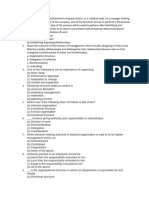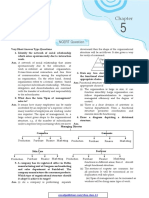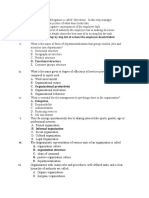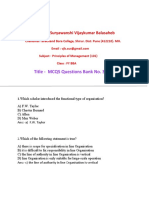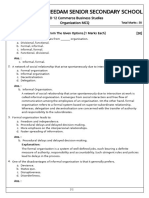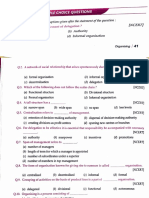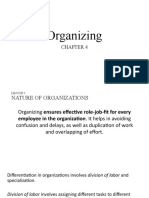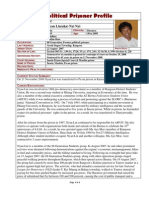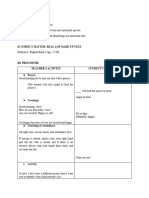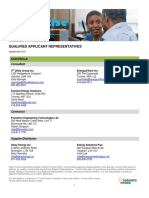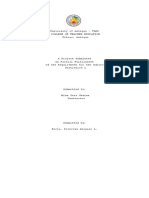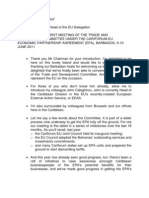Studies Principles and Functions of Management Chapter 5
Uploaded by
tingtongasmykStudies Principles and Functions of Management Chapter 5
Uploaded by
tingtongasmykwww.ncrtsolutions.
in
NCERT Solutions for Class 12 Business
Studies Principles and Functions of
Management Chapter 5
Organising Class 12
Chapter 5 Organising Exercise Solutions
Multiple choice questions : Solutions of Questions on Page Number : 142
Q1 :
Which of the following is not an element of delegation?
(a) Accountability
(b) Authority
(c) Responsibility
(d) Informal Organisation
Answer :
Informal Organisation is not an element of delegation. Delegation refers to the transfer of
authority to subordinates. Accountability, responsibility and authority are the major elements of
delegation. On the other hand, informal organisation refers to the relationship which arises out of
informal communication among the employees in an organisation. Such communication is purely
informal in nature and does not involve any formal communication such as that in delegation.
Q2 :
A network of social relationship that arise spontaneously due to interaction at work is
called:
(a) Formal Organisation
(b) Informal Organisation
(c) Decentralisation
(d) Delegation
Answer :
Material Downloaded From http://www.ncrtsolutions.in
www.ncrtsolutions.in
A network of social relationship that arise spontaneously due to interaction at work is called
informal organisation. It emerges from social interaction and free flow of communication among
the employees of an organisation. On the other hand, formal organisation refers to a formal
system based on superior-subordinate relationship. Whereas, delegation and decentralisation are
concerned with the transfer of authority and responsibility to the subordinates.
Q3 :
Which of the following does not follow the scalar chain?
(a) Functional structure
(b) Divisional Structure
(c) Formal organisation
(d) Informal organisation
Answer :
Scalar Chain refers to a pre-defined, formal path of authority and communication in the order of
highest to the lowest. Informal organisation do not follow a scalar chain as they arise out of
informal relationship among the workers and managers. For example, it may arise from
interaction which happens over lunch or an office party. Other structures such as formal
organisation, divisional structure and functional structure follow a proper defined scalar chain.
Q4 :
A tall structure has a
(a) Narrow span of management
(b) Wide span of management
(c) No span of management
(d) Less levels of management
Answer :
A tall structure of organisation is the one that has multiple levels of hierarchy. A tall structure of
organisation has narrow span of management. That is, under such a structure a manager has
charge of only a few subordinates.
Q5 :
Material Downloaded From http://www.ncrtsolutions.in
www.ncrtsolutions.in
Centralisation refers to
(a) Retention of decision making authority
(b) Dispersal of decision making authority
(c) Creating divisions as profit centers
(d) Opening new centers or branches
Answer :
Centralisation refers to the retention of decision making authority. Centralisation implies a
situation where the decision making power is retained by the top level management. Under such
a system, other levels of management do not have a right to intervene in policy making. The
power and the authority, in such a system, remains concentrated in a few hands.
Q6 :
For delegation to be effective it is necessary that responsibility be accompanied with
necessary
(a) Authority
(b) Manpower
(c) Incentives
(d) Promotions
Answer :
For delegation to be effective it is necessary that responsibility is accompanied with authority.
Responsibility refers to the obligation to complete a task which has been assigned by the
superior. Complementary to this, authority refers to the power to give commands and directions
to the subordinates. For successful delegation both authority and responsibility must go together.
That is, if an individual is given the responsibility to carry out a task, he must also be given the
necessary authority to carry it out.
Q7 :
Span of management refers to
(a) Number of managers
(b) Length of term for which a manager is appointed
(c) Number of subordinates under a superior
Material Downloaded From http://www.ncrtsolutions.in
www.ncrtsolutions.in
(d) Number of members in top management
Answer :
Span of management means the number of subordinates that can be well-handled by a superior.
Any organisational structure is based on its span of management.
Short answerslong answersmultiple choice questions : Solutions of Questions on Page
Number : 143
Q1 :
Define 'Organising'?
Answer :
Organising refers to the procedure of aligning the activities in a certain order. It contains
designing the roles and directing the people towards accomplishment of goals. Human efforts
along with the resources are brought together and coordinated under this function. The focus of
the function lies in enabling people to work together and implementing the plans for successful
attainment of objectives. Through organising the working relationships of an organisation gets
clearly defined, thereby ensuring its smooth functioning. The process of organising involves
i. Identifying the work and dividing them according to the plans
ii. Grouping the work of similar nature and making departments for the same.
iii. Assigning authorities to the right personnel
iv. Designating the reporting relations
Q2 :
Why is delegation considered essential for effective organising?
Answer :
Delegation implies transfer of authority, from a superior to his subordinate. It is an essential
concept for effective organisation as it lowers the burden on the manager and thereby, facilitates
the manager to focus on activities that command high priority. Also, the managers can extend his
area of operations once he delegates the work to subordinates. In addition to this, it provides the
subordinates with more opportunities for growth. It helps in efficient completion of tasks as the
subordinates can now show their skills and exercise initiative. The following points highlight the
importance of delegation in effective organising.
Material Downloaded From http://www.ncrtsolutions.in
www.ncrtsolutions.in
(i) Managerial Efficiency: Delegation of the work to the subordinates, help the managers to
concentrate on other areas of concern. With delegation of routine work to the subordinates, the
manger can focus on other high priority areas. Besides, it provides them the opportunity to
explore and innovate into new areas. For example, if the manager delegates the basic work to the
subordinate he can put his mind into exploring ways to improve efficiency.
(ii) Employee Proficiency: By delegating the work, managers empower his subordinates by
providing them opportunities to apply their skills. Herein, the subordinates get a chance to prove
his abilities, gain experience and develop his career. Thus, delegation in a way helps in preparing
future managers.
(iii) Motivation: Along with improving the managerial and employee efficiency, delegation
provides the employees with the psychological benefits. It acts as a motivational guide for the
workers. It imparts a feeling of mutual trust and commitment between the superior and
subordinate. With responsibility the employee gains confidence and he gets encouraged to give
their best to the organisation.
(iv) Growth: Delegation facilitates easy growth and expansion. Delegation helps in the
preparation of efficient and experienced mangers that can take up leading positions at times of
growth of the organisation. That is, workers trained and prepared through delegation contribute
to the expansion and growth of the organisation more efficiently.
(v) Hierarchical Structure: Delegation forms the basis of the hierarchical structure of an
organisation. It decides the superior-subordinate chain and determines who has to report to
whom. It clearly states down the reporting relationships which helps in smooth working of the
organisation.
(vi) Coordination: Delegation promotes coordination of work. It reduces overlapping of work by
defining the reporting relationships. All the elements of delegation such as authority,
responsibility and accountability helps in providing a clear working relationship, thereby,
increasing efficiency.
Q3 :
What are the steps in the process of organising?
Answer :
The following are the steps involved in a successful process of organising.
(i) Identifying and Dividing the Work: Under organising, the very first step deals with
identifying the activities and dividing them according to the defined plans. The actions are
divided as per the objectives. A clear division of work is done so as to avoid any duplicity.
(ii) Creating Departments: Herein, the divided actions are further grouped into units based on
the similarity in nature. That is, similar activities are grouped together. Such departmentalisation
promotes specialisation. Each department specialises in a particular task. Departments can be
formed on the basis of several criteria such as working profiles, regions, product, etc.
Material Downloaded From http://www.ncrtsolutions.in
www.ncrtsolutions.in
(iii) Assigning Duties: The third step under organising deals with assigning the roles and
responsibilities to the personnel. Under each department work is allocated to different members
as per their skill and ability. While assigning the duties it must be ensured that the best suited and
proficient person is selected for the work.
(iv) Establishing the Relationships: Any organisation needs a proper hierarchic structure to
work efficiently. Every person should know whom he's working under and to whom he needs to
report. Clear establishment of such relationships help in smooth functioning of an organisation.
Q4 :
What is divisional structure? Discuss its advantages and limitations.
Answer :
Divisional structure refers to an arrangement where activities are separated on the basis of
products. There are different units and divisions which deal with varied products. Each division
has its own divisional manager who supervises the whole unit and has the authority for it.
Organisations that are large in size and deals in a diversified range of products or categories opt
for this type of structure. Under each head of divisional structure, a functional structure develops
itself, i.e. each divisional unit is further divided on the basis of its functions. For example, a
company dealing with varied products have divisional heads such as clothing, shoes and
electronics. Now these units will have further functional departments such as, under shoes, there
will be resource inputs, advertising, production, sales, etc. Similarly, under clothing also there
will be departments of resources, advertising, production and sales. The same will be under the
electronics division. Here, each division has to take care about its profit and loss and is
responsible for its own work.
Following are a few prominent advantages of a divisional structure.
(i) Managerial Efficiency: Divisional structure facilitates the development of the managers and
the workers by providing them numerous opportunities. Along with product specialisation it also
leads to development of the skills and knowledge of the working personnel. The divisional head
gains experience as he deals with a vast variety of functions which he has to be responsible for.
This helps him to grow and become more proficient in his working.
(ii) Gauging Performance: Under divisional structure each head is responsible for the profit and
loss of his own division. This helps in clear identification of the performances by each
department separately. Once the head is accountable for the revenues and costs of their own
department, it becomes easier to gauge the actions of each. This also helps in taking corrective
actions in case of poor performance.
(iii) Flexibility and Initiative: As under divisional structure, each division functions
independently, decision making becomes quick. Once the departments are divided, the heads
have the authority to take their own decisions whenever needed. This promotes initiative among
the personnel as they are now able to take decisions at the right place and right time.
Material Downloaded From http://www.ncrtsolutions.in
www.ncrtsolutions.in
(iv) Growth: Under divisional structure expansion of an organisation becomes easier as new
divisions can be easily added without affecting the functioning of other divisions.
A divisional structure has certain disadvantages as well. The following are some of
the disadvantages of a divisional structure.
(i) Departmental Conflicts: Strife may arise among various divisions with regard to decisions
and actions of organisation such as those relating to allocation of funds and resources. For
example, suppose a company dealing in leather products such as shoes, bags, etc. decides to
allocate the resource (workforce) to each department. Here, a conflict may arise among different
division as which department gets more workforce.
(ii) Increase in Cost: Under divisional structure duplication of activities takes place. As there are
same set of functions in each department, the probability of overlapping of activities occur. This
results in a rise in cost for the organisation. For example, suppose there are two units of
advertising in two different product divisions and they follow the same techniques of advertising.
Now, although the products are different but still due to the same methodology, the cost to the
organisation increases as the duplication of work takes place.
(iii) Ignorance of overall objectives: One of the disadvantages of having divisions is that in due
course of time, there may be chances that the organisational goals take a back-seat. Divisional
heads handling different units mainly focus on attainment of their own divisional objectives. This
may lead to ignorance of the organisational objectives as a whole and in the race of getting ahead
each department may target their own interests at the cost of the overall interests of the
organisation.
Q5 :
Discuss the elements of delegation.
Answer :
Delegation refers to the transfer of authority and responsibility to the subordinates. The
following are the basic elements of delegation.
(i) Authority: It refers to the power given to an individual to command and direct the
subordinates. It implies the right to take decisions regarding what is to be done and by whom.
Scalar chain in a formal organisation gives rise to authority as it entails the link between various
jobs and determines the relation of who is to report to whom. It is a downward flowing channel,
i.e. superior commands authority over the subordinates. The extent of authority at the top level
management is the highest and it becomes lesser at the middle level and the lowest at the lower
level management. However, the scope of authority delegated, depends on the rules and
regulations of the organisation. Assigning authority helps in maintaining obedience and
compliance.
(ii) Responsibility: Responsibility refers to the adherence and answerability of the subordinate to
complete the given task. That is, once a duty has been assigned to a subordinate, it is his
responsibility to perform the task properly. A subordinate should be obedient and loyal towards
Material Downloaded From http://www.ncrtsolutions.in
www.ncrtsolutions.in
the duty assigned to him. The superior-subordinate relationship gives rise to a sense of
responsibility. As against authority, responsibility flows upward i.e. the subordinate is
responsible to his superior. However, care should be taken that while assigning responsibility to
a subordinate, he must also be given a certain degree of authority. On the other hand, an
individual who is given authority must also have some responsibility. This is because authority
without responsibility may lead to the misapplication of power. On the other hand, responsibility
without authority may lead to inefficiency.
(iii) Accountability: Accountability implies the answerability of the superior for the final
outcome of the work he assigned. Though the superior delegates the work to his subordinate but
he still will be responsible for the final outcome. For this the superior, through regular feedbacks
and supervision ensures that the subordinate performs the tasks properly and satisfactorily. The
concept of being accountable arises out of responsibility itself. We may say that while
responsibility is assumed, accountability is imposed.
Q6 :
Decentralisation is an optional policy. Explain why an organisation would choose to be
decentralised.
Answer :
Decentralisation refers to the dispersal of the decision making power among the middle and
lower level managers. It is an optional policy as it depends on the organisation how much power
the top level management wants to delegate to the lower levels. An organisation may choose to
be centralised or decentralised depending on the objectives and the decisions of the top level
managers. Following are a few factors that explain why an organisation would choose to be
decentralised.
(i) Initiative: Decentralisation allows a sense of freedom to the lower managerial levels as it lets
them take their own decisions. It gives them a higher degree of autonomy to take initiative.
Moreover, it promotes a feeling of self-confidence and self-reliance among them. When the
power is delegated to lower level managers, they learn to face new challenges and find solutions
for the problems themselves. This helps in spotting those potential managers who can take the
needed initiative.
(ii) Managerial Competence: Once the authority is delegated to the managers at lower levels, it
provides them the needed opportunity to develop themselves. It provides them with the
opportunity to gain experience and thereby, develop the skills and knowledge to face new
challenges. Decentralisation gives them a chance to prove their talent and get ready for higher
positions. It also helps in pre-identification of the future managers who are well-equipped with
the necessary talent required to deal with managerial problems.
(iii) Control: Decentralisation helps in evaluating the performance of the organisation in a better
manner. Decentralisation helps in analysing and evaluating the performances of each department
separately. Thus, the extent of achievement of each department and their contribution to the
overall objectives of the organisation can be easily can be easily evaluated.
Material Downloaded From http://www.ncrtsolutions.in
www.ncrtsolutions.in
(iv) Active Decision Making: Since through decentralisation, the authority of making decisions
is passed on to lower levels of management, decisions are taken quickly and timely. This is
because the decision can be taken at the nearest points of action which thereby, helps in easy
adjudication of the problems.
(v) Growth: Managerial efficiency is developed to a large extent with the help of
decentralisation. Decentralisation results in greater authority to the lower level managers. It
promotes competition among the managers of various departments. In a race to outperform each
other, they give their best shot and thereby, increase the overall productivity and efficiency. The
organisation gains from the increased overall performance and thereby, grows.
(vi) Reduced Workload of Top Managers: Delegation of authority provides freedom to top level
managers. It helps them in shifting the workload to their subordinates and gives them time to
concentrate on more important and higher priority work such as policy decisions. Moreover,
direct supervision by the top level management is decreased, as the subordinates are given the
rights to take the decisions by their own.
Q7 :
What does the term 'span of management' refer to?
Answer :
Span of management refers to the number of subordinates that a manager can efficiently handle.
It is the determining factor for the nature and structure of an organisation. Span of management
can be classified into the following two categories.
i. Narrow Span of Management: If the number of subordinates reporting to a particular manager
is small, the span of management is said to be narrow. Narrow span of management leads to tall
organisational structures that have multiple levels of management.
ii. Wide Span of Management: Span of management is said to be wide if, there are large number
of subordinated reporting to a manager. Wide span of management leads to flatter organisational
structures with only a few levels of management.
Span of management depends on various factors such as ability of the manager in terms of
leadership, control, etc., extent of decentralisation followed in the organisation, working ability
of the subordinates, nature of work, etc.
Q8 :
How does informal organisation support the formal organisation?
Answer :
Material Downloaded From http://www.ncrtsolutions.in
www.ncrtsolutions.in
Informal organisation refers to a complex network of relations that arises out of the social
interactions outside the office. They originate from within the formal organisation and are not
deliberately created by the management. These relations are based on the friendship which
develops between the working personnel on the basis of like nature. Following are the factors of
informal organisation that support the working of formal organisation.
(i) Free Flow of Communication: Informal organisation helps in establishing a free flow of
communication. It allows the workers to form informal relations outside the organisation. This
facilitates faster spread of information, thereby assisting the formal organisation. For example, if
A needs to talk about a problem to E. In a formal structure he'll have to follow a scalar chain
which may lead to delay in finding a solution for it. Thus, he can discuss it over lunch, thereby,
shortening the length of communication.
(ii) Coordination: Through informal relations, working people develops a sense of
belongingness towards each other and towards the organisation. This helps them over the
working place as well. It promotes coordination among them by developing mutual trust and
understanding. Thereby, it results in lowering down the rate of conflicts between the people. For
example, if A and B are friends outside the office, then, they will work in coordination with each
other at the work place as well.
(iii) Organisational Objectives: Along with the personal goals, informal relations help in
fulfilling the organisational objectives as well. The managers can interact with the workers
informally and assess their reactions on various matters. They can ask the workers for their
suggestions and ideas regarding the inadequacies in the formal structure. Thereby, contributing
to the overall organisational objectives in a better way.
(iv) Harmonious Environment: By developing healthy relationships, informal structure helps in
building a harmonious working environment. It encourages cooperation between the people and
maintains a peaceful environment at work. For example, if C and D have a dispute over some
matter. They can discuss it outside the office and solve it without harming the formal working
environment. Thus, conserving the amiable working environment.
(v) Efficiency and Productivity: Informal organisation fosters efficiency among the working
personnel. By contributing to their well being, it helps in increasing their productivity. Such
relations help in fulfilling the social and psychological needs of the employees and thereby,
increase their efficiency.
Q9 :
Under what circumstances would functional structure prove to be an appropriate choice?
Answer :
A Functional structure entails organising and grouping together activities of similar nature. That
is, under functional organisation activities or work of similar nature are grouped together. Each
group functions as a separate department and specialises in its work. For example an
organisation can have departments such as production, human resource, finance, marketing, etc.
Material Downloaded From http://www.ncrtsolutions.in
www.ncrtsolutions.in
Each department in turn report to one coordinating head. Functional structure is usually suitable
for large organisations who deal with number of varying functions requiring high degree of
specialisation. The following points highlight the suitability of functional structure.
i. Large Size: A large size organisation can function smoothly, if the work is divided into various
departments. Departmentalisation in large organisation improves managerial efficiency and the
degree of control. Thereby, the work proceeds smoothly.
ii. Varying Functions: Dealing with diverse varying functions simultaneously requires high
degree of coordination so as to improve efficiency. By a clear division of activities in various
departments, a functional structure promotes coordination among the various functions and
thereby, ensures smooth functioning.
iii. Requirement of Specialisation: Varying functions in an organisation can be performed better
if dealt with specialisation. With departmentalisation, each department can function
independently and specialise in their respective functions.
Q10 :
Distinguish between centralisation and decentralisation.
Answer :
Following are the differential factors between Centralisation and Decentralisation.
Basis of Difference Centralisation Decentralisation
Authority Authority remains concentrated only in f Authority is delegated to lower levels
ew hands at the higher level of manage of management.
ment.
Creativity Restricts creativity of middle and lower Promotes creativity and innovation a
level managers. all the levels.
Work Load Higher work load on the top level mana Lesser workload as sharing of author
gers. y and responsibility is done.
Scope of Delegation Scope of delegation is limited as power i Wider scope of delegation as authori
s concentrated in a few hands. can be transferred.
Subordinate Initiative Limits the scope of initiatives by subord Encourages the subordinates to come
inates as the workers have to work on th orward and take initiative as they are
e pre-decided path. llowed the needed freedom for worki
g.
Decision Making The decision making is slowed down as The decision making is quick as the a
the power lies only with the top manage uthority lies near the actual action.
ment. The problem has to pass through d
ifferent levels before an action is taken.
Material Downloaded From http://www.ncrtsolutions.in
www.ncrtsolutions.in
Q11 :
Draw a diagram depicting a divisional structure.
Answer :
Sometimes when an organisation has more than one product line, it groups its activities on the
basis of the product line. Such grouping of activities on the basis of product line is known as
divisional structure. Each division in the organisation specialise in their respective product lines.
Further, each division has multiple functions under it such as production, sales, marketing, etc.
That is, within each division there is a functional structure.
Suppose an organisation deals in four product lines namely, footwear, garments, jewellery and
leather accessories. Based on these product lines, the organisation has four divisions that report
to the managing director. Each division further has four departments namely, production, sales,
marketing and advertising. The divisional structure for such an organisation is depicted by the
following diagram.
Q12 :
Can a large sized organisation be totally centralised or decentralised? Give your opinion.
Answer :
No, any organisation cannot work smoothly if it is either completely centralised or completely
decentralised. Rather a balance is required between the two.
Centralisation refers to a situation where the decision making power is concentrated only in the
hands of the top level management. Herein, only the top level managers are authorised to take
the needed decisions. All the functions related to policy making, planning and controlling are
Material Downloaded From http://www.ncrtsolutions.in
www.ncrtsolutions.in
curtailed to the top level management. In contrast to this, decentralisation refers to a situation
where the decision making power is delegated to the lower level managers. Herein, the power of
taking actions and deciding the policies is distributed at different levels.
An organisation cannot function either with extreme centralisation or with extreme
decentralisation. As an organisation grows in size, it cannot maintain complete centralization.
Rather, a need arises to move towards decentralisation. For a smooth functioning, the individuals
involved in the actual work must have certain degree of authority and responsibility. With
decentralisation, the overall management of the work becomes more efficient. It allows for better
control of the work at each level of hierarchy. Moreover, as the organisation grows in size,
decentralisation would facilitate quick decision making. This is because in a decentralised
system the decision making power is near the point of actual work. Thereby, the delay in work is
avoided.
However, an organisation cannot also follow extreme decentralisation. If all the decision making
power is delegated to the lower level managers, then it may harm the harmony of the
organisation. It is possible that lower level managers at each department mould the rules and
policies according to their own convenience and thereby, diverge from the organisational goals.
Thus, certain degree of authority and control must be retained at the top level management so as
to maintain integrity of the organisation.
Hence, we can say that a large sized organisation cannot be totally centralised or totally
decentralised, rather it must maintain a balance between the two.
Q13 :
Decentralisation is extending delegation to the lowest level. Comment.
Answer :
Both decentralisation and delegation relate to downward delegation of authority and
responsibility. Under delegation, the authority is shared by the superior to the immediate
subordinate. On the other hand, under decentralisation this concept is extended and the authority
is distributed at not just one but multiple levels. That is, while delegation involves just two
persons, i.e. the superior and subordinate, decentralisation is a wider concept of the same
(delegation) where the power gets transferred to numerous levels. For example, suppose the
director of an organisation delegates the responsibility of completing a task, hiring the required
workers and supervising them to a project head. The project head in turn shares his responsibility
of hiring and supervising the workers with the project lead. The project lead further delegates the
responsibility of supervising the workers to the team lead. Thus, delegation at each level from
the director, to project head, project lead and further to the team lead results in decentralisation.
Hence, it can be said that delegation at each level leads to decentralisation and decentralisation is
extending delegation to the lowest level.
Material Downloaded From http://www.ncrtsolutions.in
www.ncrtsolutions.in
Q14 :
The form of organisation known for giving rise to rumours is called
(a) Centralised organisation
(b) Decentralised organisation
(c) Informal organisation
(d) Formal organisation
Answer :
Rumours are a result of informal organisation. They can have adverse effect on the working
environment. It may result in arguments or conflicts among the people of the organisation. For
example, a rumour about the boss may pop up during a communication among a group of
employees, which may affect the superior-subordinate relationship.
Q15 :
Grouping of activities on the basis of product lines is a part of
(a) Delegated organisation
(b) Divisional organisation
(c) Functional organisation
(d) Autonomous organisation
Answer :
Sometimes an organisation has more than one product line. Under such a scenario the
organisation groups the activities on the basis of the product line. Such a grouping of activities
on the basis of product line is known as divisional organisation. Each division further has its own
sub-departments such as production, finance, etc.
Q16 :
Grouping of activities on the basis of functions is a part of
(a) Decentralised organisation
(b) Divisional organisation
(c) Functional organisation
(d) Centralised organisation
Material Downloaded From http://www.ncrtsolutions.in
www.ncrtsolutions.in
Answer :
Functional Organisation involves grouping of the functions of similar nature. Each group forms a
separate department that report to one head. For example, departments may be divided on the
basis of functions such as production, human resources, etc. that report to the managing director
of the organisation.
<< Previous Chapter 4 : PlanningNext Chapter 6 : Staffing >>
Long answers : Solutions of Questions on Page Number : 144
Q1 :
How is functional structure different from a divisional structure?
Answer :
The following points highlight the difference between a functional structure and a divisional
structure.
Basis of Difference Functional structure Divisional structure
Creation These are created on the basis of fu These are created on the basis of
nctions. product-lines along with the fun
ctions.
Costs It is economical as duplication of w It is costly as there is higher rate
ork is minimised. of duplication of work and resou
rces between various departmen
ts.
Decision Making Decision making is centralised as th Decision making is decentralise
e decisions are taken by the coordin d as each division of the product
ating head for various departments. line have their own decision ma
king authority.
Duplication of work Due to functional specialisation ove Due to each product department
rlapping of work is minimised. having the same functions, overl
apping of work is increased.
Suitability More suitable for companies who fo More suitable for multi-product
cuses on 'operational specialisation'. companies focussing on 'differe
ntiated products'.
Functional Hierarchy Horizontal functional hierarchy is f Vertical functional hierarchy is f
ormed while the departments are de ormed while devising the depart
vised on the basis of key operations. ments on the basis of product-li
ne categories.
Material Downloaded From http://www.ncrtsolutions.in
www.ncrtsolutions.in
Management Management is difficult as each wor Management is easier as differe
k has to report to a coordinating hea nt line of department is formed f
d at the top level of management. or each product.
Material Downloaded From http://www.ncrtsolutions.in
You might also like
- NCERT Solutions For Class 12 Business Studies - OrganisingNo ratings yetNCERT Solutions For Class 12 Business Studies - Organising38 pages
- OrganisingNCERT Solutions & Case StudiesNo ratings yetOrganisingNCERT Solutions & Case Studies11 pages
- Ncert Sol Class 12 Business Studies Chapter 5 OrganisingNo ratings yetNcert Sol Class 12 Business Studies Chapter 5 Organising11 pages
- Chapter 5 - Organising Ncert Base Complete Important Questions - 1No ratings yetChapter 5 - Organising Ncert Base Complete Important Questions - 112 pages
- NCERT Solutions For Class 12 Business Studies Chapter 5 OrganisingNo ratings yetNCERT Solutions For Class 12 Business Studies Chapter 5 Organising6 pages
- MCQS Question Bank No. 3 For FY BBA Subject - Principles of Management PDF0% (2)MCQS Question Bank No. 3 For FY BBA Subject - Principles of Management PDF15 pages
- Class 12 Business Studies Chapter-5 Organising Important Questions100% (1)Class 12 Business Studies Chapter-5 Organising Important Questions11 pages
- Give Me All Answer in Short With Question.No ratings yetGive Me All Answer in Short With Question.4 pages
- Class XII Business Studies Chapter-5 Notes 2023-24 UpdatedNo ratings yetClass XII Business Studies Chapter-5 Notes 2023-24 Updated15 pages
- FMOB RESEARCH PAPER - Organising As A Function of ManagementNo ratings yetFMOB RESEARCH PAPER - Organising As A Function of Management16 pages
- Class Xii Business Studies Organizing: Reason-Based, Evaluation & HotsNo ratings yetClass Xii Business Studies Organizing: Reason-Based, Evaluation & Hots13 pages
- Case Study Organising 25th July UpdatedNo ratings yetCase Study Organising 25th July Updated24 pages
- Enhelion Knowledge Ventures Private LimitedNo ratings yetEnhelion Knowledge Ventures Private Limited6 pages
- Arts in Healthcare: State of The Field ReportNo ratings yetArts in Healthcare: State of The Field Report33 pages
- Detailed Lesson Plan in English Real and Made-Up100% (1)Detailed Lesson Plan in English Real and Made-Up5 pages
- Durga Puja Celebrations Begin in Port BlairNo ratings yetDurga Puja Celebrations Begin in Port Blair8 pages
- Gender Representation in Cambodian English TextbooksNo ratings yetGender Representation in Cambodian English Textbooks13 pages
- World's Iconic Women Leaders in Travel & Hospitality, 2025No ratings yetWorld's Iconic Women Leaders in Travel & Hospitality, 202544 pages
- Complainant vs. vs. Respondent: en BancNo ratings yetComplainant vs. vs. Respondent: en Banc152 pages
- Rumi and Sufism'S Philosophy of Love: Diffusion: The Uclan Journal of Undergraduate Research (Volume 8 Issue 1 June 2015)0% (1)Rumi and Sufism'S Philosophy of Love: Diffusion: The Uclan Journal of Undergraduate Research (Volume 8 Issue 1 June 2015)11 pages










